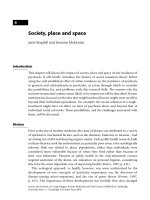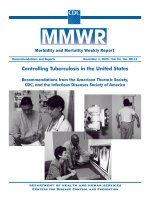Society, place and space
Bạn đang xem bản rút gọn của tài liệu. Xem và tải ngay bản đầy đủ của tài liệu tại đây (287.62 KB, 18 trang )
6
Society, place and space
Jane Boydell and Kwame McKenzie
Introduction
This chapter will discuss the impact of society, place and space on the incidence of
psychosis. It will briefly introduce the history of social causation theory before
using the well established effect of urban residence on the incidence of psychosis
in general, and schizophrenia in particular, as a lens through which to consider
the possibilities for, and problems with, this research field. The reasons why the
socioenvironmental context seems likely to be important will be described. Recent
attention has focused on the idea that neighbourhood factors might exert an effect
beyond their individual equivalents. For example, the social cohesion of a neigh-
bourhood might have an effect on rates of psychosis above and beyond that of
individual social networks. These possibilities, and the challenges associated with
them, will be discussed.
History
Prior to the rise of modern medicine, the cause of disease was attributed to a variety
of spiritual or mechanical factors, such as the elements, humours or miasma – bad
air arising out of dirt and decaying organic matter. Early public health research, built
on these theories, took the environment, in particular poor areas, to be aetiologically
relevant. Risk was related to place; populations, rather than individuals, were
considered more vulnerable because of where they lived rather than because of
their own behaviour. Pioneers of public health in the mid-nineteenth century
targeted sanitation of the slums, not education on personal hygiene, considering
this to be the most important way of improving health (Porter, 1997, p. 411).
This ecological approach to health, however, was soon undermined by the
development of new concepts; of particular importance was the discovery of
disease-causing micro-organisms, and the rise of germ theory (Porter, 1997,
p. 415). The importance of these developments was twofold: first, they changed
Society and Psychosis, ed. Craig Morgan, Kwame McKenzie and Paul Fearon. Published by Cambridge
University Press. # Cambridge University Press 2008.
the target of investigation from the community as a whole to pathological agents in
the community; and second, they moved the place for investigation of aetiology
away from the community and into the laboratory (and the individual).
Germ theory was useful, but had its problems. For instance, not everybody
exposed to infection contracts a disease. Exposure, though necessary, is not always
sufficient to produce illness. Because of this and other deficiencies, the so-called
‘epidemiological triangle’ approach was developed. This renewed interest in the
environment but still did not bring it back centrally into the causal pathway. It
posited that disease is the product of an interaction between an agent, the host and
the environment. The host and environment determine exposure and susceptibility.
An example would be methicillin-resistant Staphylococcus aureas (MRSA) infection,
which is a current scourge of UK hospitals. The environment has a part to play, in
that poor hospital hygiene increases the chance of infection being spread. However,
the weakest people in a hospital, whose immune systems are not functioning fully
(e.g., post-operative patients, the old and infirm), are most likely to develop an
infection. The risk of MRSA infection, therefore, depends on the presence of the
bug in the hospital, the hospital environment and individual vulnerability.
Although the epidemiological triangle works well for infectious disease, it is
more difficult to apply to chronic illnesses, such as psychotic disorders. The
problem is that there is often no specific agent or exposure. There is a web of
causation. Disorders develop through the complex interactions of many factors
over time, which form interlocking chains of events (Krieger, 1994). Here, the
environment is important, but only as a site for risk factors or behaviours that
increase risk. The general move has been towards the individualisation of risk and
away from the ecological basis of risk that was the genesis of public health.
However, some theories have continued to emphasise the importance of society
and community. They have thrived because there are significant differences in rates of
illness between groups, which are not explained by known risk factors (e.g., residents
in urban and rural areas), and because some social groups seem to be at increased risk
for a number of disparate disorders (e.g., migrants). There are some general theories
of susceptibility that do not identify single or even multiple risk factors associated
with specific disorders, but seek to understand why some social groups are generally
more at risk than others for a range of illnesses. One incarnation is the fundamental
social cause hypothesis (Link and Phelan, 1996). This attempts to explain why
disparities in illness remain between socioeconomic groups despite adequate public
health interventions. In the words of Link and Phelan (1995, p. 80), ‘...social factors
such as socioeconomic status and social support are likely ‘fundamental causes’ of
disease ...because they embody access to important resources, affect multiple disease
outcomes through multiple mechanisms, and consequently maintain an association
with disease even when intervening mechanisms change.’
78 J. Boydell and K. McKenzie
In the nineteenth century, the higher mortality and morbidity rates in the lower
social classes were primarily due to infectious disease. Public health interventions,
such as sanitation and vaccination, had a significant impact on disparities resulting
from infections, but the differences in life expectancy between the social classes
remained. Over time, the reasons for these disparities were no longer infectious
disease, but became chronic diseases, such as cardiac problems (Link and Phelan,
1996). The theory of fundamental social causes aims to identify factors, such as
education, access to prevention messages and access to healthcare, that work
together to produce health disparities. Such fundamental causes are lodged in
the fabric of society rather than in the individual. This theory has heralded a recent
return to ecological considerations of aetiology (Diez-Roux, 1998).
A further move in this direction has been the social capital literature (McKenzie
and Harpham, 2006). Social capital is a way of understanding communities and how
their structure and function affect rates of mental illness. It is a group of concepts that
includes individual and ecological factors. These may prove to be powerful predic-
tors of rates of mental illness and outcome, but the concepts and methodologies are
still under revision and there is significant work needed before any conclusions can
be drawn (McKenzie and Harpham, 2006, pp. 151–7). What is exciting is that the use
of multilevel modelling techniques has allowed social capital to be measured at
ecological and individual levels in the same data sets. This has made it possible to
disentangle the impact of the social environment on the individual from the impact
on the group (McKenzie and Harpham, 2006, pp. 86–109).
Conceptualising society, place and space
Over time, society, place and space have been conceptualised in a number of
different ways (see Chapter 4). The environment has been considered as a cause of
illness at a population level and at an individual level, and as a vector of risk factors
at an individual level.
Psychiatrists and social scientists have a long history of interest in the impact of
society, place and space on the aetiology of mental illness. For instance, Durkheim
(1951) developed theories that linked social structure and suicide (see Chapter 3);
Faris and Dunham (1939) investigated the social organisation of cities and mental
health (see Chapter 4); and Leighton (1982), Freeman (1994) and others (e.g.,
McKenzie et al., 2002) have been interested in the impact of societal and socio-
cultural change on mental health.
There have been a number of attempts to describe society and social structure.
Economic variables have been considered significant. They have included concepts
of wealth, income inequality and poverty; both absolute poverty (money needed to
sustain life) and relative poverty (the money needed to be able to have a normal life
79 Society, place and space
within a society). Many types of inequality cluster together – the financially poor
are often disadvantaged in accessing high quality education, decent housing, and
so on. These socially structured inequalities have been studied through concepts
such as social class, poverty and social exclusion. Socioenvironmental stressors,
such as crowding, crime and fear, have been less well conceptualised and studied,
at least in relation to mental illness.
Social context is considered so important in the understanding of symptoms
and illness that it has been written into psychopathological definitions and diag-
noses. But it is often unclear what that context is; whether it should be considered
as acting on individuals or whether it should be considered to be truly ecological
(i.e., acting at a group level). Because of this, it is difficult to know how far this
understanding helps us in developing healthy communities. A classic example of
this is urbanisation. On a population level, the most important risk factor for
psychosis is being born and brought up in a city. We will use this as a model for the
investigation of how society, place and space may affect aetiology.
Methodological issues
To understand theories of how urbanisation may cause mental illness, one has
to accept some simple premises. The first is that psychosis often develops over a
life course, with a balance of propsychotic (i.e., risk-increasing) and antipsychotic
(i.e., risk-reducing) factors moving individuals up or down a scale of risk
(Figure 6.1).
Propsychotic and antipsychotic risk factors are complex and exist at a number
of discrete levels. For instance, a non-exhaustive list of levels would be molecular,
genetic, individual, interpersonal and environmental (Figure 6.2). Investigation of
the cause of psychosis is complicated by the fact that each of these levels is
No
psychotic
symptoms
Prepsychosis
Psychotic
symptoms
Psychotic
symptoms
+ impairment
Psychosis
diagnosis
Propsychotic factors
Antipsychotic factors
Figure 6.1 Life course journey to a diagnosis of psychosis
80 J. Boydell and K. McKenzie
governed by different scientific rules and so different tools are needed for assess-
ment (Susser and Susser, 1996).
It is perhaps easier to understand this by considering the case of smoking and
premature death. Those who smoke have an increased risk of developing a variety
of cancers and cardiovascular disease. The rates of illness in groups who smoke are
increased. To build an evidence-based strategy to decrease the impacts of smoking
on health, we may want initially to investigate the mechanisms through which
smoking has its effects. The mechanisms can be interrogated in a number of ways
and at a number of levels, as follows:
*
Molecular level How do nicotine and tar affect the contents of a cell?
*
Metabolic level How do cell death and disruption affect other bodily systems?
*
Individual level Why does the individual smoke, why can’t the individual stop
and what can the individual do to decrease the risk that
smoking causes?
*
Group level Why do certain social groups smoke more than others?
*
Societal level Why do some societies have higher rates of smoking than
others and what can be done legislatively to decrease the rate
of harm from smoking?
Environmental
Interpersonal
Individual
Genetic
Molecular
Figure 6.2 Multilevel causation of psychosis
81 Society, place and space
Investigations at each of these levels have the same aim – to examine the mechanisms
linking smoking to illness. However, the analytical tools needed, and the relevant
theory and scientific rules at each level, are different, as are the inferences that can be
made from the research. Using the tools and methodology of molecular biology to
investigate societal-level factors is unlikely to work very well. Similarly, we are unlikely
to understand an individual’s metabolic pathophysiology by using a systems theory of
group dynamics. Investigating smoking legislation and tariffs may give an indication
of why the rate of smoking is higher in one country than another, it may give
information on why there are consequent increases in, for instance, cardiovascular
illness in one area or another, but it does not give information on an individual’s risk
of harm if he or she is a smoker or why one person smokes and another does not.
The possible impact of a factor at any level is constrained by the higher level. To
understand causation, we need not only to measure the impact of a factor at a
given level, but also to understand the interaction with other levels.
There are particular difficulties in studying geographical variations in mental
health. In such ecological studies, the exposure (risk factor) is measured at the group
level (population or subpopulation) and the outcome is usually the proportion of
the group who develop the disease. These aggregated data have some advantages in
that there is less random error, more power and less selection bias, but also the
disadvantage that one can never be certain that those who developed the disease
were those who were exposed. Grouped results tell us about the group but not
necessarily about the individuals within the group. For instance, if there was an
association between the incidence of schizophrenia and the rate of crime in an area,
it could not be assumed that being a victim of crime would increase an individual’s
risk of developing the disorder. Making such individual-level inferences from
ecological-level data is termed the ‘ecological fallacy’. Further, any systematic differ-
ences between areas or groups in the recording or classification of exposure or
disease will bias the results in ecological studies. It is also sometimes difficult to
identify ecological confounders and effect modifiers, as populations might differ in
many ways, such as diet, alcohol consumption and attitudes that may affect the
outcome (disease) being measured. Nevertheless, ecological studies are of great value
in generating hypotheses and investigating phenomena that only exist at a group
level. We now turn to the specific example of urbanicity and psychosis.
Urbanisation literature review
Incidence rates in rural and urban areas
Faris and Dunham (1939) reported that first-admission rates of schizophrenia
were particularly high in certain areas of inner-city Chicago, and decreased
82 J. Boydell and K. McKenzie
towards the periphery (see Chapter 4 for a detailed summary). Furthermore, there
were considerable differences within the inner city itself, with rates being higher in
the more disorganised areas, irrespective of deprivation and ethnicity. Faris and
Dunham suggested that the nature of living conditions in certain neighbourhoods,
particularly extended isolation, produced abnormalities of behaviour and men-
tality, which subsequently led to increased rates of schizophrenia. A number of
other early studies (reviewed by Freeman (1994)) also demonstrated clearly that
the rates of schizophrenia increase towards city centres in Western societies.
The generally accepted view for most of the twentieth century was that the high
rates of schizophrenia in the inner city could be accounted for by the drift of people
with, or beginning to develop, schizophrenia into the more urbanised and anony-
mous areas (the ‘social drift’ hypothesis). A variant on this theme suggested non-
balanced migration, i.e., that as a city develops, the more able move out to better
areas, leaving a residual population in the centre with a high risk of psychiatric
disorders (previously called the ‘social residue’ theory). The idea that causal agents
are associated with urbanisation (the ‘breeder’ hypothesis) was largely dismissed. It
has only been relatively recently that these ideas have been revisited.
In a study looking back at the nineteenth century, Fuller Torrey et al. (1997)
used the comprehensive 1880 census of the ‘insane’ in the USA to examine the
association between urbanicity and severe mental illness. They calculated preva-
lence rates for different degrees of urbanicity, characterised as follows:
*
Urban 30 largest cities;
*
Semi-urban 50% or more people living in towns of greater than 4000 people;
*
Semi-rural 25–50% living in towns of 4000 or more people;
*
Rural 1–25% living in towns of greater than 4000 people;
*
Completely rural no-one living in a town of greater than 4000 people.
Fuller Torrey et al. (1997) found a strong linear trend, with the prevalence in urban
areas being 66% higher than in completely rural areas. This study is fascinating,
despite its limitations, because a gradient was found between areas that would all
be considered rural today.
Most recent research has come from Northern Europe where good quality
national records have made large-scale epidemiological studies possible. In the
first of these, Lewis et al. (1992) investigated the association between place of
upbringing and incidence of schizophrenia using data from a cohort of over
49 000 male Swedish conscripts, linking it to the Swedish national psychiatric
register. They found a strong significant linear trend. The highest rate of clinically
diagnosed schizophrenia was in those who had mostly lived in cities (Stockholm,
Go
¨
teborg, Malmo
¨
) while they were growing up (odds ratio (OR) 1.65). There were
intermediate rates in towns with populations greater than 50 000 (OR 1.39), and
towns with populations less than 50 000 (OR 1.28), compared with baseline country
83 Society, place and space









